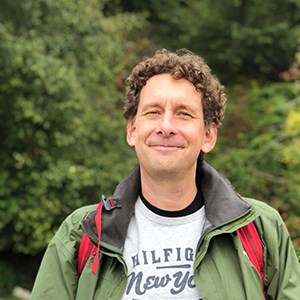Facts:
Interviewed by Magnus Trogen Pahlén.

Urban wooded areas and green spaces are key to better health and more sustainable cities. Cecil Konijnendijk van den Bosch stresses the importance of green urban development to achieve the UN Sustainable Development Goals (SDGs).
Konijnendijk van den Bosch, professor of Urban Forestry at the University of British Columbia (UBC), together with several colleagues, recently wrote a chapter for the “Sustainable Development Goals: Their Impacts on Forests and People” research paper. In it, the researchers describe, among other things, the linkages between the SDGs and green urban environment.
SDG 11 in particular, which seeks to “make cities and human settlements inclusive, safe, resilient, and sustainable”, highlights the role of urban development, says Konijnendijk van den Bosch.
“Although most of the SDGs can be linked to green urban development, the goals are focused on people’s health and wellbeing, which is also the aim of our work,” he explains.
There are many advantages to green cities, he says. Cities’ green areas and woodland play an important role in adapting to climate change. At the same time, they contribute to a city’s appeal by attracting people and businesses.
“Cities that fail to develop their green spaces will find it difficult to succeed in a global marketplace. Over the longer term, they won’t be able to attract people or businesses.”
However, nowhere near everyone has realized the importance of urban green spaces for the development of cities. Competition is fierce from other urban development needs such as new housing and infrastructure, which are frequently prioritized over green spaces.
“We need to get our research to a wider audience by repackaging it in different ways for different target groups, as well as highlighting good examples such as Malmö and Stockholm that have been two highly successful cities in Sweden,” he says.
He also gives the example of Melbourne in Australia and Singapore, where green spaces have been well integrated with other infrastructure.
Although urban woodland and green spaces can help us to manage climate change, climate change itself poses a threat to urban green spaces. This is an area in which Konijnendijk van den Bosch’s research group is working by mapping and evaluating different ecosystem services in relation to urban woodland development. For example, which species of trees are better at mitigating climate change than others.
“We work quite a bit in China where we provide knowledge related to strategies, planning, and legislation. Rapid change is underway in China, and there’s considerable interest in urban green spaces.”
Today, Konijnendijk van den Bosch is based at UBC in Vancouver, Canada. His research has taken him all over the world and for a time he was visiting professor and department head at SLU.
“Sweden is a green urban development leader in Europe, especially in terms of urban forestry management. There’s a lot of research being done in the field of Urban Forestry here, which is one of the reasons I chose SLU,” he says.
His own interest for urban woodland and green cities can be traced back to his childhood. A typical weekend family outing would involve hiking in nearby woods.
“My parents were extremely good at triggering our interest in the natural world. I’ve always been fascinated by the interaction between people and nature, so Urban Forestry was a good choice.”
Interviewed by Magnus Trogen Pahlén.